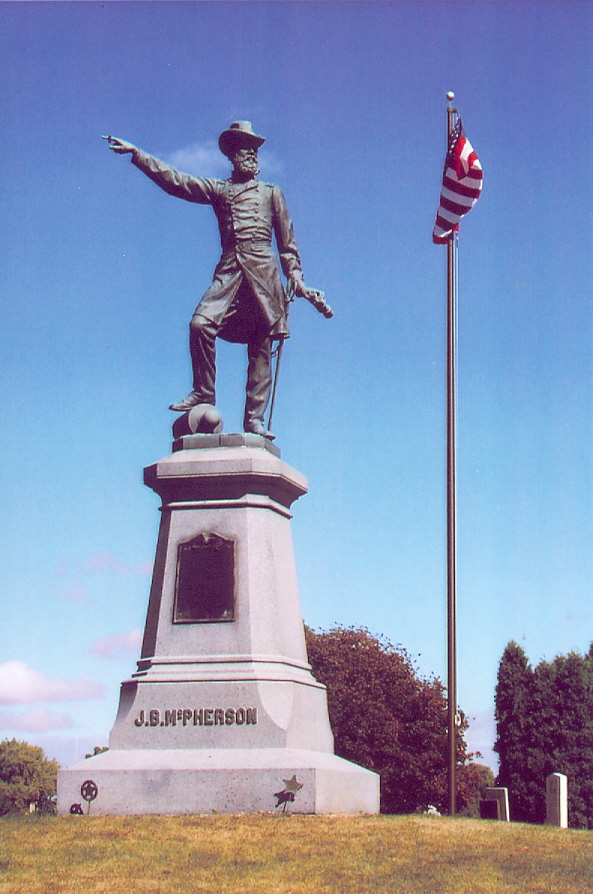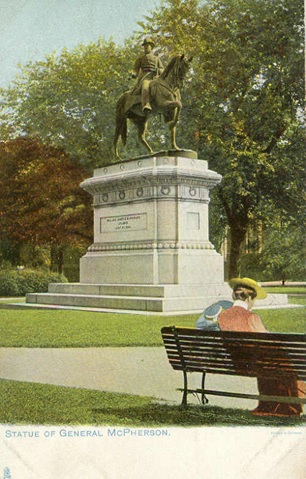General James B. McPherson Tombstone
McPherson Cemetery
Clyde, Ohio

A vacation trip in 2003 took me across northern Ohio. With my interest in both the Civil War and in cemeteries, I planned a stop in the small hamlet of Clyde to see the McPherson monument on the grave of General James B. McPherson killed at the Battle of Atlanta in 1864. I soon learned that there was quite a story to go with this grave marker as well.
James McPherson had been born in 1828 and through the effort of friends had secured an appointment to West Point some twenty years later. He proved to be an outstanding cadet and four years later graduated No. 1 in his class. One of his fellow classmates was John Bell Hood of Texas who was destined to command Confederate forces at Atlanta the day that McPherson was killed in action.
McPherson enjoyed a meteoric rise in rank during the Civil War and soon became a Brigadier General in the regular army serving under Sherman in the Army of the Tennessee. When Grant moved east to Washington in 1864 to assume command of all Union Armies, Sherman moved up to replace him in the western theater. In turn, Sherman immediately tapped McPherson to assume his old command with the Army of the Tennessee.
Sherman was soon laying siege to Atlanta with McPherson at his side. On July 22, McPherson and other senior officers had attended a command conference with Sherman. Upon its conclusion McPherson travelling but with a single orderly back to his own lines was surprised by a small group of Confederate skirmishers. Resisting capture he was immediately shot from the saddle and instantly killed, the highest ranking Union officer killed in the entire Civil War. His body was shortly retrieved by his own men who carried him to Sherman’s headquarters on an old farm door ripped from its hinges. It is said that upon seeing his fallen friend, Sherman broke down and wept openly – something very much out of character for him. Even, Confederate general Hood, upon learning of his former classmate’s death, expressed deepest sympathy and regret.
McPherson’s remains were soon prepared for shipment home to Clyde for burial which occurred one week later. His funeral was a simple military procession for a hometown hero with the usual dignitaries and military personnel present. Escort from his home to his grave site was provided by the 128th Ohio Volunteer Infantry and the 24th Ohio Battery. At the conclusion of graveside services, the 128th assembled in two ranks fired the standard three volleys in salute, taps were sounded and the service ended.
Following the committal service there was considerable talk but little action concerning plans for an appropriate monument at graveside. For twelve years the necessary money could not be found. Then, events outside of Clyde provided the impetus for breaking the stalemate and placing the monument that now stands atop his grave.
The event that changed the status quo occurred at one of the first reunions of the Army of the Tennessee when the assembled veterans voted to honor McPherson with a monument to be placed in Washington, D.C. The resolution enjoyed the support of the three ex-Union Generals, Grant, Sherman and Logan, who had fought with and commanded McPherson in battle. $23,500 was promptly raised and a lobbied Congress voted to donate Confederate cannon captured at the Battle of Atlanta to be melted down and recast as the statue. The Congress also appropriated $25,000 for a base and pedestal.
The sculptor chosen for the work was Louis Rebisso, and his design featured a larger than life McPherson astride his horse surveying the battlefield gazing into the distance with binoculars in his right hand and the reins of a spirited horse in his left. The uniform was sculpted to show creases and rumpling from weeks in the saddle.
 The monument was to be placed on 15th Street between I and K Streets. It was then announced that a burial crypt was included in the plans and that McPherson’s mother had given her permission for McPherson’s remains to be reinterred under the monument. The news swept through Clyde like a firestorm igniting howls of protest. Tempers flared and accusations of grave robbing flew about as inaccurate newspaper reports fanned the flames. A committee of local businessmen was formed to guard the grave day and night. A city councilman promised that gunpowder would be used if there was any attempt at snatching McPherson’s body.
The monument was to be placed on 15th Street between I and K Streets. It was then announced that a burial crypt was included in the plans and that McPherson’s mother had given her permission for McPherson’s remains to be reinterred under the monument. The news swept through Clyde like a firestorm igniting howls of protest. Tempers flared and accusations of grave robbing flew about as inaccurate newspaper reports fanned the flames. A committee of local businessmen was formed to guard the grave day and night. A city councilman promised that gunpowder would be used if there was any attempt at snatching McPherson’s body.
Only gradually did the full truth come out. The plan to move McPherson’s remains was partly due to McPherson’s fiancée living in Baltimore, who had never married following his death, and wanted McPherson’s grave moved closer to her. She had begun some of the lobbying for a monument later approved by the veterans of the Army of the Tennessee and had gone directly to Grant and Sherman seeking their help. Once plans were in place and secured by the necessary funding, Grant, himself, had contacted McPherson’s aged mother back in Clyde seeking her approval for the re-internment.
The citizenry in Clyde prevailed. A last minute court injunction kept McPherson safe in Clyde. Despite the setback, the unveiling of the Washington monument went forward and it was dedicated on October 18, 1876. It was a relatively low key simple affair with Sherman presiding and Logan giving the main address on the theme “sacrifice”. The monument still stands in Washington as dedicated with an empty grave crypt beneath the base and pedestal
The citizenry of Clyde still felt betrayed. To their way of thinking, the monument they always sought for McPherson’s grave was now in Washington, D.C. In time the angers calmed and a renewed fund raising effort was undertaken. This time it was successful and on July 22, 1881, the 17th anniversary of McPherson’s death, 10,000 local citizens, residents and politicians joined family members to dedicate a second monument placed atop his grave in Clyde, Ohio.
Today the cemetery in Clyde is named McPherson Cemetery; the adjoining road is McPherson Boulevard. The local Middle School carries the name McPherson in his honor. Other references to Clyde’s native son can be seen throughout the town. The grave is well cared for and a bigger than life Gen. McPherson stands with a drawn sword pointing towards the town’s center. He almost looks as if he, too, would resist any attempted removal to Washington.